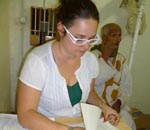Bibiana Ruberte traveled for two months to the Sahrawi refugee camps to coordinate and follow first-hand the organized activities on the ground during the last quarter of the year. Her stay coincided with the controversial evacuation that the Moroccan army carried out in the Agdeim Izik camp, which demanded better conditions of life for the Sahrawi population, and the subsequent clashes in the city of El Aaiun, in the Western Sahara. We took the opportunity to discuss this and other topics with the Eyes of the Sahara’s programme coordinator, as she completes her second year in this positon.
Despite being more than 500 kilometers away, how the incidents have been expeienced in the camps of Tindouf?
In general we have lived through them nervously and confused, above all because of the disinformation of the first few days and because the dismantling of the camp coincided with the start of negotiations between the two sides of the conflict in New York. The refugee Sahrawi population asked the representatives of the Polisario Front for a return to arms and called on the international community in regards to human rights in the occupied territories. It must be said that the displaced staff of Eyes of the world at the time did not have a sense of insecurity and that we were able to implement the activities as planned.
Can you tell us anything about the Foundation’s gender study carried out within the Eyes of the Sahara programme?
During the past few years, we have detected that the percentage of women that receive ophthalmological and optical care is less than the percentage of men (this situation gets worse if we take into account that the Sahrawi population is eminently female). I believe that the success of the effects of our programmes depends to a large extent on the ability to provide different responses according to the needs of women and men. That is why we hired gender specialist Paula Señán, who traveled for two months to the camp with the goal of identifying variables that negatively impact women’s attendance of ophthalmology services.
How do you assess the role of the counterpart, the Ministry of Health and the Ophthalmology Service, now that it has been taking responsibility for some time?
In 2008 we started the transfer of responsibility of project management to the main local actors, who assumed new roles such as the detection of needs or the implementation of prevention and training activities. This new intervention strategy was aimed at reorienting the project towards progressive sustainability, keeping in mind the constraints of an inhospitable and geographically and economically closed context. With the renewal of the agreement between the Ministry of Health and Eyes of the world (May 2010) and, according to the results of recent years, we can say that this assumption of responsibilities is being achieved progressively.
For the first time, a long-term programme is being carried out in the Sahara (2010-2012). This is a challenge, isn’t it?
Since the project began in 2001, annual interventions had always been proposed. Presenting a long-term programme shows the strengthening and growth of the Foundation, and also entails the assumption of a new responsibility for the entire task force: to establish new challenges and objectives with the mindset of doing things in the best way possible. At a personal level, being the coordinator of this programme implies an important social responsibility that is further accentuated during trips on the ground. It must be said that it is very easy to carry out this work with the support of the colleagues of Eyes of the world, of the volunteers who year after year make the activities a reality and also the local counterparts that work for our programme to achieve our goals.
How would you explain what the camps are and what life is like there to a person who has never been there?
The refugee camps and Sahrawi refugees are organized in four wilayas that have the same names as the main cities of the Western Sahara; El Aaiun (the capital of Western Sahara), Smara (the holy city), Dajla (the most important port city) and Auserd (a small city located in the inland of the country). Each wilaya is divided into dairas and each daira into four neighborhoods. Each Sahrawi family has a haima that protects them from hard weather conditions and that symbolize the nomad spirit and remind them that every day they are closer to their home. In the camps you immediately feel at home, it is a place that takes you away from the demons of everyday life.
